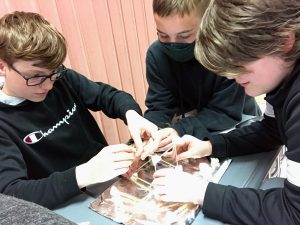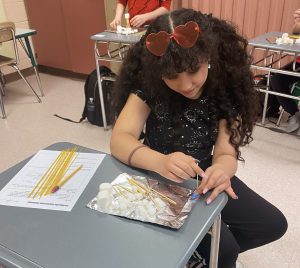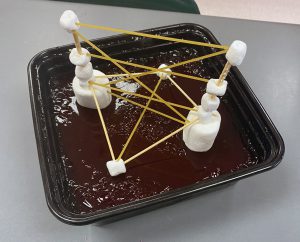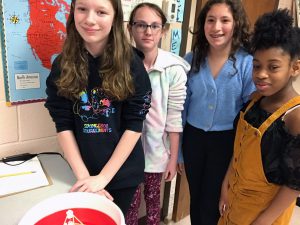 Sixth-grade science curriculum includes learning about earthquakes, and middle school faculty have made that topic even more interesting with an innovative lab involving marshmallows, Jell-O and spaghetti.
Sixth-grade science curriculum includes learning about earthquakes, and middle school faculty have made that topic even more interesting with an innovative lab involving marshmallows, Jell-O and spaghetti.
Lynn Villa and Jaclyn Lockett’s sixth-grade science classes have been learning about what causes earthquakes, how to predict them and precautionary measures that can be taken.
This fun, STEM-centric lab allowed students to identify some of the factors that make buildings earthquake-proof; model an earthquake-proof structure  using simple materials and what that represents; understand why engineers need to learn about earthquakes; and how they use that knowledge to design more ‘earthquake-proof’ structures.
using simple materials and what that represents; understand why engineers need to learn about earthquakes; and how they use that knowledge to design more ‘earthquake-proof’ structures.
As part of their lab work, students learned there needs to be reinforcement and a flexible base for a building or structure to be considered earthquake-proof. They were challenged to construct an earthquake-proof building with the unique supplies: Large and small marshmallows, tooth picks, tin foil and spaghetti.
Waves of energy moving through the earth in an earthquake can be a difficult concept for students to understand. A pan of Jell-O is a simple classroom  model for demonstrating wave motion and explaining how earthquake damage happens.
model for demonstrating wave motion and explaining how earthquake damage happens.
The pan of Jell-O represents “the ground,” which moves during an earthquake. Students tapped or shook the pan to demonstrate the waves moving through ”the Jell-O ground.” During an earthquake, the ground can move the same way Jell-O does. There can be much damage to buildings.
That’s because the Earth is made up of large pieces of rock called tectonic plates. Where two tectonic plates meet is called a fault. If two plates rub  together at a fault, waves of energy (seismic waves) come to the surface of the Earth. Those waves of energy, or shaking, are felt as an earthquake.
together at a fault, waves of energy (seismic waves) come to the surface of the Earth. Those waves of energy, or shaking, are felt as an earthquake.
Certain structures are able to withstand more shaking than others. Through their lab work, students noticed structures built with a large base and had larger marshmallows at the base seemed to withstand the “earthquake.”
“Through this STEM activity, our students were able to demonstrate their knowledge and had a blast doing so,” said Mrs. Lockett.
See more photos on the district’s Facebook page.
